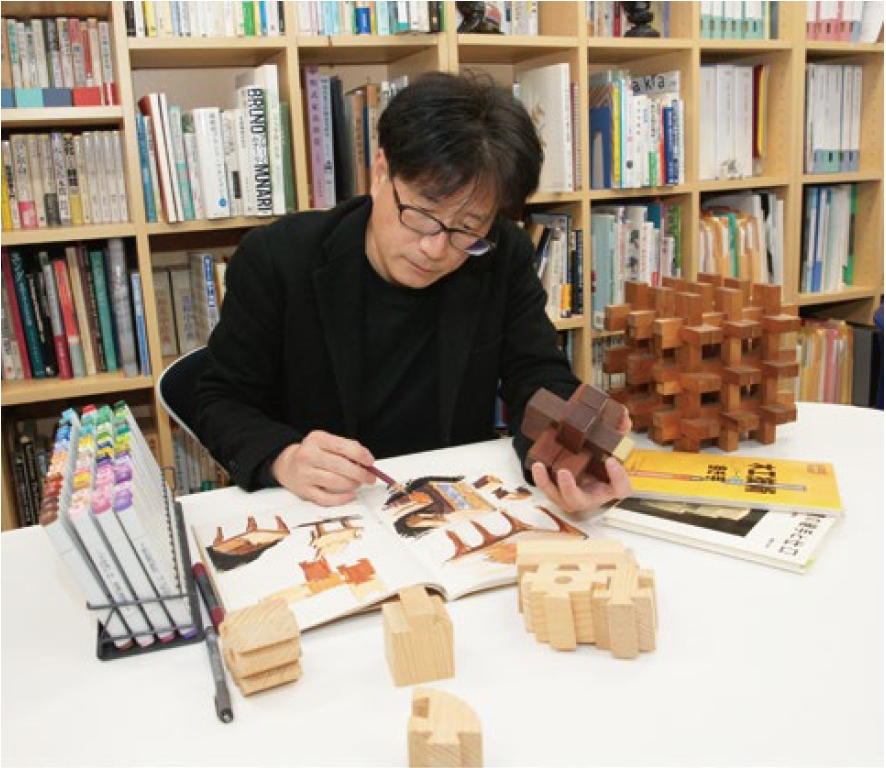Hope for the Creation of Wood Art in Taiwan
Takamitsu Tanaka / Professor, Iwate University, Japan
"Hope for the Creation of Wood Art in Taiwan"
Introduction|Coexistence and Collaboration in Woodworking
First and foremost, I would like to make sure that we’re on the same page: when we work with wood, use wood to manufacture products, and use these products, we must always stay grateful to Mother Nature. Forests provide us with fresh air, help preserve water sources, and prevent landslides. Most importantly, when forests disappear, life itself can no longer be sustained.
Wood products are made, naturally, with one of the most precious resources on Earth, so we cannot afford to be wasteful. By this, I do not mean that we should be tight-fisted with the material; I mean that we should not manufacture products that are not needed.
In Japan, about 69% of the land is forested; in Taiwan, it is about 60%. Of course, forest coverage varies due to the natural environment (for example, high-altitude countries would naturally have less forest cover). Compared with neighboring Asian countries, 48% of Indonesia is forested; Thailand, 39%; China, about 25%. This shows us the extent of success to which Taiwan and Japan coexist with their forests.
Before the rise of civilization, people everywhere used wood to create hunting tools or to build shelter. Taiwan and Japan are both island countries, and I can safely assert that woodworking techniques came to both our countries from mainland Asia. The National Museum of Nature and Science in Japan, after repeated experimental voyages, has proven that it was possible for humans as early as 30,000 years ago to sail 200 kilometers on wooden canoes from the eastern beaches of Taiwan to Japan’s Yonaguni Island. It can therefore be inferred that woodworking techniques from Taiwan 30,000 years ago provided the foundation for Japanese woodworking of today.
From this historical background, it seems that Taiwan and Japan were destined to work together in developing woodworking techniques and design.
Establishing Taiwanese Furniture as a Brand
We can identify differences in appearance and usage between the West and Asia when we examine the history of wood crafts and furniture development. As an Asian living in Japan, I became fascinated by the design of Western wood furniture since my youth. Walking the streets of London, you can find many antique shops selling wood furniture from a century ago.
There is Nothing Unusual About This
Wood furniture is not disposable; it can be repaired, renovated, and passed down through multiple generations. What about in Japan? Many places still have traditional furniture that has been preserved for over 300 years. Yet, many of these pieces still extant today boast designs from centuries ago and do not necessarily suit the needs of modern living spaces.
Interestingly, it now seems that people overseas prefer Japanese designs from centuries past over more modernistic design styles. This preference is not limited to wood furniture—it extends to dyed textiles, iron tools, ceramics, and other crafts. Traditional wood furniture in Asia can be traced back to China, where it was historically crafted with the highest level of skill and reserved for the wealthy. For instance, in the past, only a select few could afford or were permitted to sit in chairs. These chairs, therefore, were not just functional items—they were works of art, showcasing superior craftsmanship and visual elegance. You can still see these pieces in museums today, and compared to Western chairs from the same period, there is a clear distinction in their design character.
Today, Nordic furniture is celebrated globally for its design. It has built a strong international brand identity, with many manufacturers continuing the Bauhaus school’s legacy of minimal, waste-free product design. Research has shown that the history of furniture-making in Scandinavia is actually much shorter than in Asia. So, how did Nordic furniture gain such widespread popularity?
This is a question worth contemplating for both Taiwan and Japan. I believe Scandinavian furniture is so well received due to its minimalistic design aesthetic, its philosophy of avoiding waste, and its integration of design into the entire product development and commercialization process. In other words, Scandinavian furniture may not be stylistically flamboyant, but it is beautiful in its understated simplicity.
The challenge for Japanese furniture design is that while there are successful regional brands—like Tendo Mokko and its iconic butterfly stool—Japan has yet to produce a globally recognized brand of furniture akin to those from Scandinavia.
So what is the path forward for Taiwanese woodworking? I believe there is no need to imitate Nordic furniture by producing similar or identical designs. Instead, we should focus on creating original designs that carry a distinct Taiwanese identity. Only through such efforts can we establish “Taiwanese furniture” as an internationally recognized brand.
About Design Competitions
Competitions play a crucial role in a designer’s journey. I personally participated in many design competitions during university. I experienced many defeats, but each loss gave me an opportunity to analyze the winning works and understand why I fell short. These moments were some of the most valuable learning experiences in my early career.
Eventually, when I started receiving shortlist mentions and awards, the frustration gave way to a sense of confidence. Most people who enter competitions will not win any recognition. But those who leave feeling disappointed, and wonder why they didn’t win, are the ones who tend to push themselves harder and return even stronger. On the other hand, those who believe there is nothing they can do to stand out among 500 entries are the ones who are likely to give up. I believe the true purpose of entering any competition is to receive an objective evaluation of your work.
With regard to this competition, I noticed that many of the youth division submissions demonstrated strong technical experimentation in form and styling. Many pieces were highly challenging to construct with wood, and too labor-intensive for mass production. This is not necessarily a flaw—complex and ambitious designs are what push the boundaries of craftsmanship. It is then the responsibility of manufacturers to rise to these challenges.
However, I did find that many participants pursued complexity in form without enough consideration for functionality. For example, some submissions featured drawers that could not open smoothly, or chairs that lacked lumbar support. My advice would be to invite a broader range of objective feedback during the prototyping phase, so these practical issues can be identified early.
Accessibility should also be a design consideration. For instance, I saw chairs that required significant physical strength to move, or knobs that could only be turned with fingertips. Designers must consider the needs of people with disabilities, seniors, and children. Thoughtful design is inclusive design.
As for the amateur and professional divisions, I believe the entries selected in the first round already demonstrated a high level of excellence. Those that advanced to the final round not only exhibited fine craftsmanship but were also designed with clear attention to their intended users, purposes, and interior layout integration. That said, even these works had minor issues. Some designs included extraneous decorative curves or non-functional elements. Designers must ask themselves: do these details enhance the product's value or function? If not, users may never progress from “satisfaction” to a deeper “emotional connection” with the object.
Regardless, I was surprised and encouraged to see how young many of the winners were. It is rare to see such youthful talent in the field, and it gives me great hope for the future. I strongly believe this competition should continue in the coming years—not only to elevate the visibility of Daxi as a brand but also to enhance the level of craftsmanship and furniture design in Taiwan as a whole.
I visit Taiwan at least five times a year and have previously lived in Kaohsiung. I believe I understand Taiwan's charm better than most. And I am convinced that Taiwanese furniture can indeed establish itself as a global brand—with Daxi as its starting point. This is my biggest takeaway from serving as a judge in this competition.

▶ This article is included in "The First Daxi International Wood Furniture Craft and Design Competition Exhibition Journal". We warmly invite you to purchase for further reading.
▶ Copyright and Licensing Statement:
All content published on this page—including but not limited to text descriptions, images, software, audio recordings, videos, and other information—is protected under copyright law. Without prior authorization, no part or whole of the website's content may be reproduced, publicly broadcast, publicly screened, publicly performed, publicly transmitted, or adapted in any manner governed by current copyright legislation. However, actions that constitute fair use under applicable copyright law are not subject to these restrictions.

